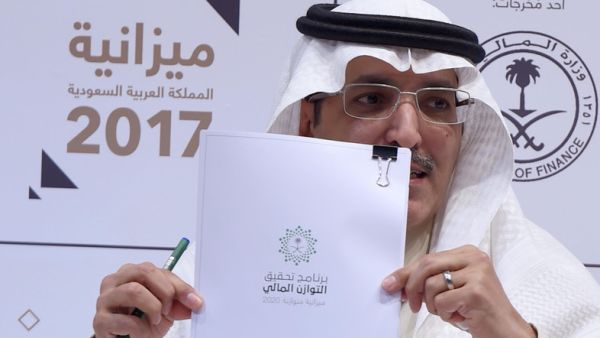The Arab Monetary Fund (AMF) released the April edition of the Arab Economic Outlook report which includes projections for the macroeconomic performance of the Arab countries in 2017 and 2018.
Read more: Foreign Direct Investment In Dubai Falls 11 Percent: Report
According to the report the global economy recorded its lowest growth rate in 2016 after the global financial crisis that started in early 2008, despite the improvement in economic performance and labour markets in some advanced countries during the second half of 2016.
On the other hand, the developing countries are still impacted by the low prices of basic commodities, tight financial conditions and increasing debt burden which affects investment spending particularly public investments.
The world economy is facing a number of challenges that inhibit a strong recovery of the global economic activities.
In this context, the weakness of investment levels and the slow growth of total factor productivity have impacted the recovery of the economic growth in the developed economies and leading to the decline in the potential output.
Read more: How Will GCC's VAT Rules Impact Commodities?
In addition, the policy space has become more limited in many of these countries in light of the increasing public debt and the overdependence on monetary policy. As for developing countries and emerging markets economies, the weak international trade growth still has been weighing on their ability to stimulate output and employment.
Furthermore, the global economy is facing new challenges in 2017 and 2018 due to the increasing levels of uncertainty related to economic policies in advanced economies and the upward tendency towards nationalism and trade protectionism which restrain the global economic recovery.
The report indicated that oil markets are expected to witness a partial recovery in 2017 and 2018 in light of the OPEC agreement to adjust oil production by 1.2 million barrel/day, and the non-OPEC oil production countries to adjust their output by 0.6 million barrel/day in the first half of 2017. The commitment to this agreement will help to bring the oil market balance in 2017.
In the meantime, oil demand is expected to increase by 1.2 million barrel a day this year according to OPEC estimates. These developments will support oil prices to increase in 2017 and 2018 compared to levels recorded in 2016 which reached $40.8/barrel for the OPEC price basket. However, the expected increase in shale oil production due to the price gains will limit the upward trend of oil prices during 2017 and 2018.
Read more: Will OPEC Extend The Production Cut Deal?
Regarding the economic growth in the Arab region, the report mentioned that the unfavourable global economic developments have impacted the macroeconomic performance of the Arab countries in light of the continuation of the sluggish recovery of the global economy, the outward of capital flows from developing and emerging markets economies, and the declining trend of oil prices.
In addition, some Arab countries have been affected by internal conditions. On the domestic level, the economic conditions required most of the Arab countries to adopt fiscal adjustment measures to ensure fiscal consolidation in Arab oil-exporting countries and to contain the increasing budget deficit and public debt levels in Arab oil-importing countries.
The global, regional and domestic developments have weighed on aggregate demand levels in Arab countries in 2016 and led to the decline in the economic growth of the region to 2.1 per cent in 2016 compared to around 3.1 per cent in 2015. This came as a result of the decline in the growth of Arab oil-exporting countries from 3 per cent in 2015 to 2.3 per cent in 2016, and the slowdown in economic activity in oil-importing countries, which recorded growth of 3.3 per cent in 2016, compared to 3.6 per cent in 2015.
Read more: Kuwait Turns To Reserves, International Borrowing To Reduce Budget Deficit
In light of the above-mentioned developments, there has been a marked shift in the policy approaches and economic reforms in the Arab region. In Arab oil-exporting countries, there has been a clear tendency towards focusing more on giving a strong impetus to economic diversification policies by adopting future national visions, strategies, and plans include quantitative objectives and operational programmes designed to achieve tangible achievements in terms of economic diversification. Attention was also placed on availing the necessary financial resources to implement the diversification plans, whether through withdrawal from reserves, privatisation, or encouraging private sector participation in the implementation of important investment projects.
On the other hand and in order to overcome internal and external imbalances, some other Arab countries, mostly Arab oil-importing countries, adopted economic reforms within the context of medium-term economic reform programmes supported by extended facilities programmes provided by the IMF with a total funding reached about $21 billion. These programmes support national economic reform plans which include several monetary, fiscal, and exchange rate regimes reforms to ensure economic stability. These reforms would contribute positively to containing economic imbalances and creating the necessary fiscal space required to support economic growth and job creation.
Read more: Egypt's External Debt Up 40.8 Percent Amid Currency Flotation
As for economic growth expectations for 2017, the report expects that the Arab economies will grow by 2.3 per cent in 2017 as a result of the decline in the growth rate of the Arab oil-exporting countries to 1.8 per cent. Additionally, the fiscal corrective measures and the anticipated increase in interest rates in a number of these countries will continue to affect the growth levels in non-oil sectors.
The growth rate of the GCC countries is expected to reach 1.7 per cent in 2017 compared to 1.9 per cent in 2016, while the economies of the other Arab oil-exporting countries are expected to grow by 1.1 per cent compared to 1.6 per cent last year.
On the contrary, the expected improvement in the economic activities in the Arab oil-importing countries will partially offset the decline in the expected growth of Arab oil-exporting countries. The former group of countries is expected to achieve a relatively higher growth rate estimated at 3.9 per cent this year amid expectations of improved external demand due to the growth of the world economy and international trade. In addition, Arab oil-importing countries will also benefit from the positive impact of economic reforms adopted to support economic growth, the improved internal conditions and the emergence of some of these countries as a regional hub for trade and investments flows.
Read more: Tunisia's Public Debt, Budget Deficit Hit Alarming Levels
With regard to the growth forecast for 2018, the pace of economic activity in the Arab countries is expected to rise to 2.7 per cent due to a number of positive factors driving growth. In oil-exporting countries, the growth rate is expected to rise to 2.3 per cent in the light of the return of oil production to previous tracks and the anticipated increase in the global oil prices, albeit at a lower rate than expected this year. These countries will also benefit from the gradual fading of the impact of fiscal corrective measures on the aggregated demand levels. In addition, the growth in some countries within this group of countries will be supported by the relative improvement in the internal conditions. The expected improvement in the economic performance of this group of countries will include both the GCC and other Arab oil-exporting countries, whose growth rate is expected to increase to 2.2 per cent and three per cent, respectively.
On the other hand, economic activities in Arab oil-importing countries will continue to improve, bringing the anticipated group's growth rate to 4.1 per cent next year due to the expected increase in external demand resulted from the gradual recovery of global economic activity, which will support export and investment levels. Economic growth rates in a number of these countries will be supported by the positive results of the economic reform policies being implemented to overcome the existing economic imbalances as mentioned before.
Concerning inflation forecasts, the AMF report pointed out that the year 2016 witnessed the rise in the inflation rate in the Arab countries as a group to about 8.4 per cent, compared with about 6.6 per cent recorded during 2015. This increase reflected the effect of reforms adopted to rationalise subsidy systems especially, for fuel and energy products in most of Arab countries, as well as the impact of measures that have been taken by some countries to rationalise imports of luxury goods as a result of pressures on the exchange rates. The inflation rate in 2016 was also affected by the internal conditions in some countries and their impact on the supply of goods and services.
Read more: Lebanon's Political Scene Is Changing, So Is Its Economy: Report
On inflation expectations for 2017 and 2018, the report mentioned that inflation rates in Arab countries will be affected by some internal and external factors. Internally, the general price level will be impacted in some Arab countries by the continuation of reforms aiming at rationalising subsidy systems, the adoption of the value added taxes as well as the tendency towards imposing taxes on harmful goods.
On the other hand the expected improvement in the agricultural production will mitigate part of the inflationary pressures in some Arab countries. On the external factors, the inflation rates will be influenced by the expected increase in international oil prices in parallel with the agreement between the main oil-exporting countries to adjust production and the expected increase in the value of the dollar against the other major currencies which will reduce the value of imports in Arab countries adopting fixed exchange rate regimes against the dollar.
Based on what has been mentioned, inflation rate in Arab countries is expected to reach 9.8 per cent and 9.6 per cent in 2017 and 2018 respectively.
On the monetary policy, the monetary conditions in the Arab countries faced pressures during 2016 due to the growing needs to finance the increasing budget deficits, while the growth rate of deposits has decreased in some Arab countries due to the declining trend of oil prices and the sluggish economic activity. These developments impacted the domestic liquidity and led to pressures on interest rates, particularly in the interbank markets. Therefore, the last year witnessed a limited growth in domestic liquidity by around 4.7 per cent for the second year in a row compared to 5.1 per cent in 2015, and half the level recorded in 2014 that marked the beginning of the downward trend in oil prices.
Read more: Central Bank Of Oman Backs Local Money Market With $154M Treasury Bills
Although several Arab countries adopting fixed exchange rate regimes pegged to the US dollar, the official interest rate in some of these countries did not reflect the Federal Reserve's decisions during 2016 due to the different economic cycle in those countries compared to the US, and the keenness of some Arab countries that adopt fixed exchange rate regimes against the dollar on keeping interest rates at relatively low levels to stimulate credit facilities to support economic activity.
As a response to liquidity pressures in some Arab countries, central banks have been active in undertaking all the required measures to alleviate liquidity strains. Furthermore, the coordination between the monetary and fiscal policy was very clear during the last year. Some Arab countries tended to external borrowing to finance part of the budget deficits to avoid crowding out private sector credit.
On the other hand, some Arab central banks, especially in the Arab oil-importing countries, continued their efforts to adopt more flexible exchange rates, either in the light of the pressures resulted from the shortage in the supply of foreign exchange or as a move to strengthen the ability of the exchange rates regimes to absorb external shocks. This shifting requires continuous efforts to improve monetary policy frameworks, enhance coordination between fiscal and monetary policies, especially with regard to the containment of deficits in the public budgets, and develop local capital markets.
Read more: Bahrain’s New Financial Reforms Promise Big Payoffs For Investors
In 2017 and 2018, liquidity pressures in the Arab oil-exporting countries are expected to ease in light of the anticipated rise in oil prices, which will support the level of deposits and provide an opportunity to channel greater credit to non-oil sectors to increase output and economic diversification levels. This trend will partially offset the contractionary impact resulted from the tightening of monetary policy in some Arab countries that adopt a fixed exchange rate regime against the dollar.
In the oil-importing Arab countries it is expected that some of these countries will continue to be affected by the tight conditions of domestic and external financing, especially in the light of the expected increase in US interest rates and the relatively high interest rates levels in some of these countries. The improvement in monetary conditions in this group of countries will continue to depend on the increase in external demand levels, which will support net foreign assets, help to provide domestic credit and reduce interest rates, as well as containing pressures on the foreign exchange markets.
Read more: Saudi Expat Remittances Drop Amid Slow Economy, Weak SME Sector
On public finance, the report referred to the acceleration of the implementation of many fiscal reforms in Arab countries in 2016. These reforms did not only cover the public revenues and expenditures, but also extended to public debt and public finance management to ensure fiscal sustainability in both Arab oil-exporting and importing countries.
In the light of the increase in the budget deficit levels, coordination between both fiscal and monetary policy was very obvious. A number of Arab countries have worked to adopt an optimal mix of financing options that ensure financing public budget deficits without crowding out private sector credit in one hand and developing local currency debt markets on the other hand. Some fiscal policy interventions have also targeted prioritising private sector disbursements to ease domestic liquidity pressures in Arab countries that have been affected by the decline in oil prices.
Find out more about the Arab Monetary Fund's April 2017 report on their website.
You can also download the full Arabic report here.








